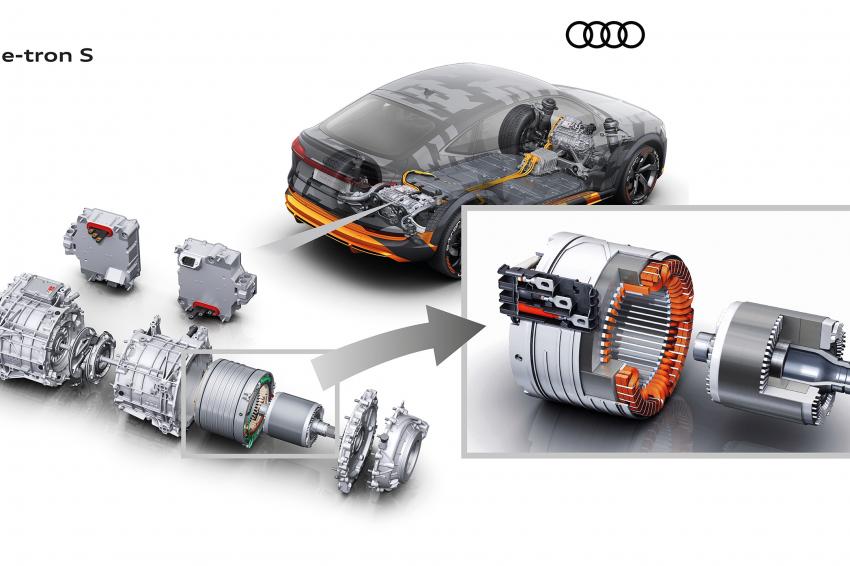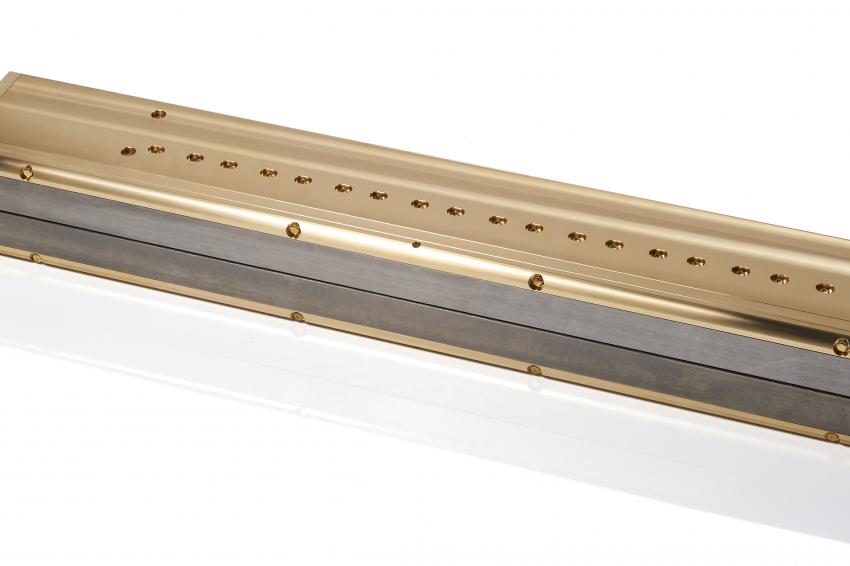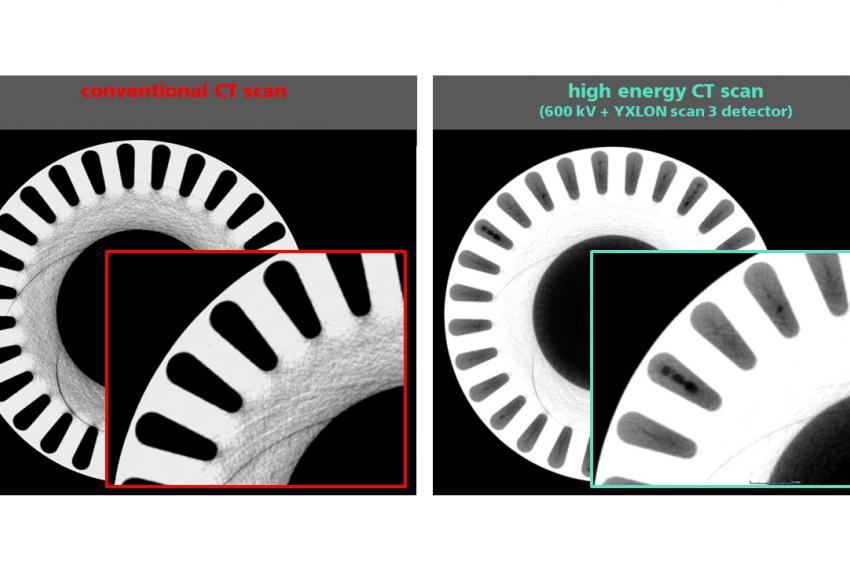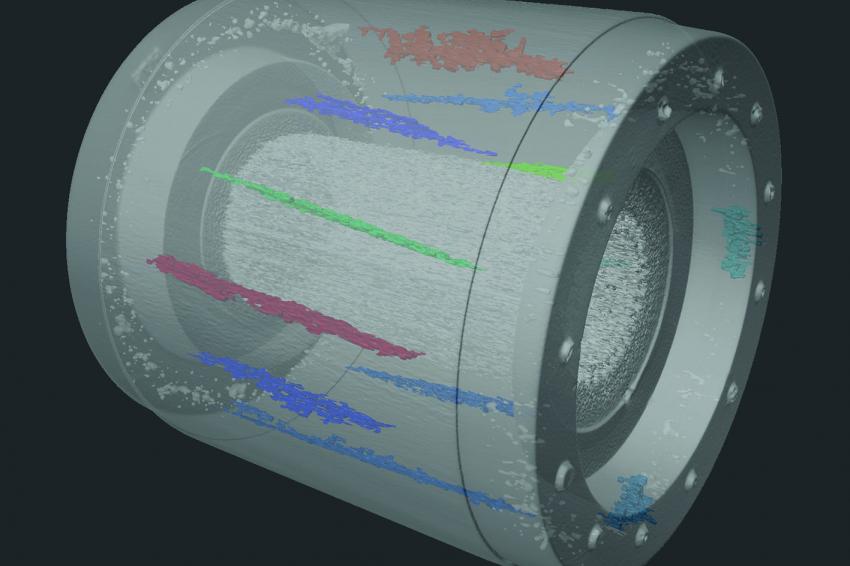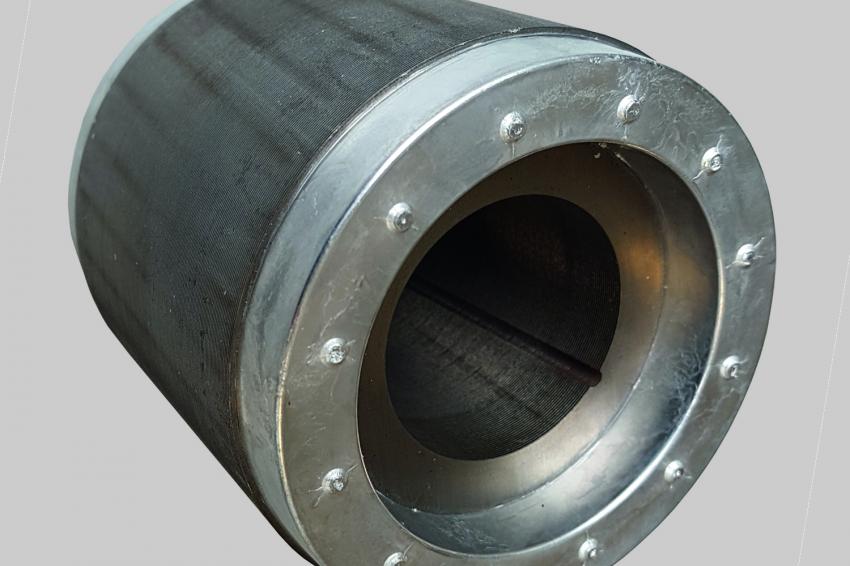The First Complete CT for Cast Rotors in Electric Asynchronous Motors
Yxlon takes a look into the Hidden
Electromobility confronts the automotive industry with many new challenges. New components sometimes require new test methods to ensure functionality and safety. Research and development are running at full blast and partnerships find solutions that clearly push the current boundaries of what is possible. In a joint project, the Fraunhofer Institute for Manufacturing Technology and Advanced Materials IFAM and Yxlon International have succeeded for the first time in taking a look into the inside of cast rotors.
The knowledge that cast rotors for electric asynchronous motors often suffer from casting defects like cavities and porosity is as old as the technology for casting rotors itself. In a so-called asynchronous machine, such as the one used in the Audi e-tron, the rotor is powered by the electromagnetic field of the coils and transmits the power generated in the electric motor via the shaft to the wheels.
Assured material- and product quality is important for the electric car’s maximum performance and thus, the driving pleasure. In the field of industrial drives, knowledge of casting defects in rotors was accepted for decades and minor losses in performance could be neglected. But since the rapid growth in electromobility, the automotive sector has been placing significantly higher demands on quality and ensured performance.
Defect Detection in Rotor Conductor Bars is Critical
So far, non-destructive quality testing of rotors has been limited to two methods: the experimental test stand and radioscopy. Although electrical performance testing on special test stands provides information about the effective performance, it does not provide any direct conclusions to be drawn about casting quality and casting defects. The relevant imaging inspection method of computed tomography (CT) however was limited to the externally exposed short-circuit rings made of cast aluminum, whose material density of 2.7 g/cm³ is comparatively low compared to the thick-walled steel sheet package (density ~ 7.6 g/cm³). However, these short-circuit rings are of secondary interest from an electrical point of view. Much more important and more critical is the detection of casting defects in the rotor conductor bars made of cast aluminum. These are “hidden” inside the lamination stack and electrically connect the two outer short-circuit rings with each other. Casting defects in these areas would lead to a reduction of the effective conductor cross-section or even interrupted rotor conductor bars due to cold runs or enclosed flow front oxide layers. Consequently, the electrical performance of the entire motor, including thermal problems, suffers directly. This means that casting defects and inhomogeneities in these areas lead to performance losses as well as one-sided magnetic pull and thus can take effect to an uneven rotation of the rotor, which can result in increased bearing loads and damage to the electrical machine, especially at high speeds.
New Insights in Internal Rotor Details
A complete CT scan of a rotor is therefore desirable but was previously not feasible due to the unfavorable material pairing of a high-density steel-based lamination stack and low-density cast aluminum rotor conductor bars. The Fraunhofer Institute for Manufacturing Technology and Advanced Materials IFAM has been engaged in the casting processes and quality improvement of rotors for many years. In cooperation with Yxlon Inspection Services, for the first time, rotors of the size of electric car traction drives were successfully scanned in the new Yxlon FF85 CT computed tomography system at 600 kV and the high-resolution Yxlon CTScan 3 line detector, providing insights into the internal details of a high-pressure die-cast rotor which were previously not possible.
The line detector CTScan 3 developed and manufactured by Yxlon International was introduced in 2018 and used for the first time in the computed tomography system CT Compact. Thanks to machine-supported cutting of the crystals, their uniformity has been improved by a factor of 5. This leads to reduced ring artifacts, and the high repeatability of the signal allows optimal calibration. Due to the higher dynamic range and better signal stability, greater material thicknesses can be tested with the same x-ray energy. The solid housing is particularly resistant to temperature fluctuations, ensuring optimized cooling of the electronics. At the same time, this material combination leads to very little scatter within the detector, resulting in sharper images, cleaner edges and an improved detail detectability.
This new success in imaging quality inspection with the high-resolution Yxlon CTScan 3 opens up new paths in the development and series production of cast rotors, and also first scans at 450 kV brought excellent results. Until now, the design of casting tools has been limited to classical simulations of mold filling and solidification. In the future, samples cast in the early prototype phase can already provide information on whether casting concepts are leading to the desired goal and whether changed process parameters influence the reduction of casting defects. Likewise, trapped gas porosity can be detected, which has arisen due to burn-off or thermal outgassing of the electrical sheet insulation coating during casting. Accompanying the series production, it is possible to control the quality by random sampling and to detect changes due to tool wear or changes in the delivered quality of the electrical lamination sheets at an early stage.
Defect specification as basis for performance calculation
The three-dimensional display of casting defects now allows the next step for rotor inspection. The Fraunhofer IFAM is working on the computer-based prediction of the real performance of rotors in consideration of casting defects. For this purpose, the previously scanned porosity model of the rotor is imported into special software which examines the effects of the reduced electrical conductor cross-sections in the rotor conductor bars due to cavities, entrapped air or other casting defects in a simulation model. The calculated reduced performance values are compared with those of an ideal rotor. This way, the determination of a "scrap factor" should be possible specifying the degree of casting defects possible for the rotor to still provide the required performance values.
Differences in defect distribution ("homogeneous fine distribution" vs. "locally inhomogeneous accumulation") do not only affect the electrical performance, torque, and heat dissipation. The so-called magnetic eccentricity is a result of unequally distributed porosity in the rotor, too. From a mechanical point of view, these resulting imbalances are currently eliminated in a simple way by individually measuring and balancing the rotors analogous to "wheel balancing". From an electrical point of view, however, the problem has not yet been solved because inhomogeneous rotor conductor bars lead to a one-sided "magnetic pull" and the rotor rotates unevenly during operation. Waviness in torque, uneven and acoustically noticeable running, especially at high speeds, and increased bearing load on the rotor shaft are the result.

